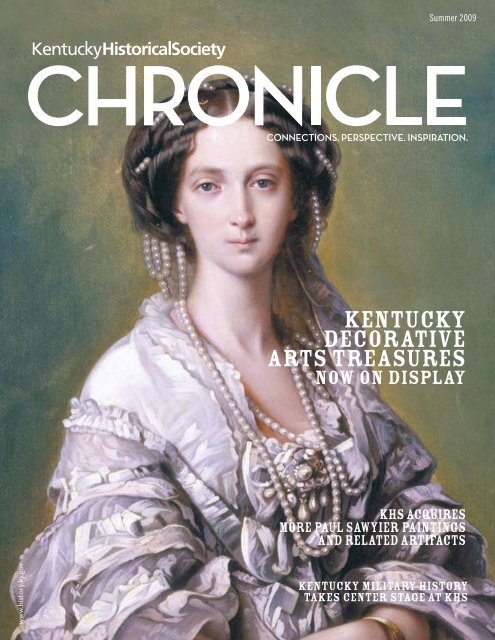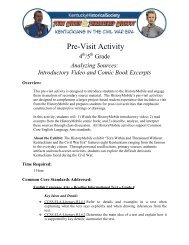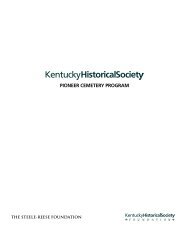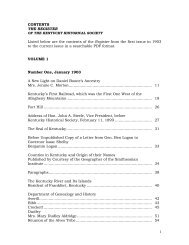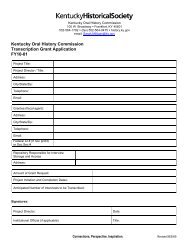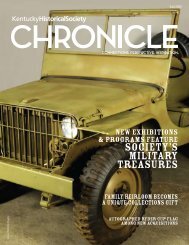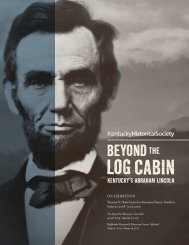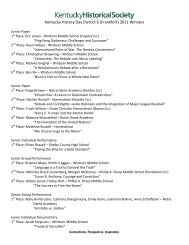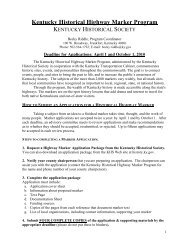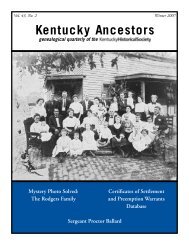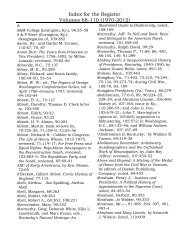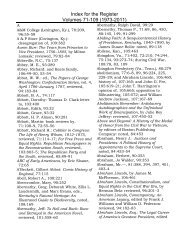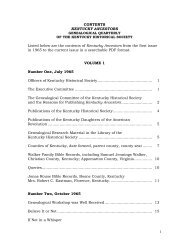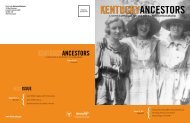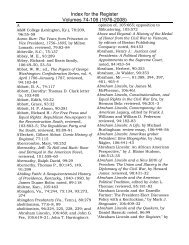kentucky decorative arts treasures - Kentucky Historical Society
kentucky decorative arts treasures - Kentucky Historical Society
kentucky decorative arts treasures - Kentucky Historical Society
You also want an ePaper? Increase the reach of your titles
YUMPU automatically turns print PDFs into web optimized ePapers that Google loves.
www.history.ky.gov<br />
Summer 2009<br />
<strong>kentucky</strong><br />
<strong>decorative</strong><br />
<strong>arts</strong> <strong>treasures</strong><br />
now on display<br />
KHS Acquires<br />
MORE Paul Sawyier Paintings<br />
and Related Artifacts<br />
<strong>Kentucky</strong> Military History<br />
Takes Center Stage at KHS
History brings families together<br />
at the<br />
Honor an ancestor or family member with:<br />
• an inscribed leaf,<br />
acorn or stone on the <strong>Kentucky</strong> Family Tree<br />
• an engraved brick on the “Pathway to History”<br />
• the gift of a KHS membership<br />
Let us help you share your family’s story with the world.<br />
Call 502.564.1792, ext. 4490 or visit www.history.ky.gov for more information.<br />
Are you ready to discover<br />
YOUR family’s unique story?<br />
MARTIN F. SCHMIDT RESEARCH LIBRARY<br />
Thomas D. Clark Center for <strong>Kentucky</strong> History<br />
100 West Broadway, Frankfort, Ky. 40601<br />
HOURS: 10 a.m. to 4 p.m. Tuesday through Saturday<br />
For visiting information, contact us at 502.564.1792 or www.history.ky.gov.<br />
This page: Earliest known image of the <strong>Kentucky</strong> Old State Capitol, Frankfort, 1859. KHS Collections.<br />
Cover: “Czarina Maria Alexandrovna,” (1824-1880), 1863, Ivan P. Federov<br />
(1859-1912) after Franz Xavier Winterhalter (1806-1873)<br />
Donated by Cassius M. Clay, 1904.7<br />
In 1869, after serving two terms as imperial ambassador to Russia, Cassius<br />
Marcellus Clay brought this portrait of Czarina Maria Alexandrovna home to<br />
<strong>Kentucky</strong>. Clay presented the portrait to the <strong>Kentucky</strong> <strong>Historical</strong> <strong>Society</strong> in 1879.<br />
The painting currently is on display at the Old State Capital in the exhibition,<br />
“Great Revivals: <strong>Kentucky</strong> Decorative Arts Treasures.”<br />
Contents<br />
6<br />
Old State Capitol Takes Center Stage<br />
“Great Revivals” Opens on Boone Day 2009<br />
11<br />
New Exhibition Strikes a Chord<br />
“Made to be Played” Features Special Musical Performances<br />
15<br />
SPecial section<br />
“Great Revivals: <strong>Kentucky</strong><br />
Decorative Arts Treasures”<br />
By Estill Curtis Pennington<br />
Summer 2009<br />
23<br />
KHS Salutes Military History<br />
Renovation continues at the <strong>Kentucky</strong> Military History Museum<br />
29<br />
New Speaker Series Scheduled for Fall<br />
Highlighting History to Offer Something for Everyone<br />
24 Featured Acquisition | More Sawyier works & artifacts<br />
27 Connections | Education Briefs<br />
29 Perspective | <strong>Society</strong> News<br />
32 Inspiration | KHS Foundation Updates<br />
5 Letter from the Executive Director<br />
26 New Collections Acquisitions<br />
34 <strong>Kentucky</strong> <strong>Historical</strong> <strong>Society</strong> Featured Events<br />
www.history.ky.gov |<br />
3
Executive Director<br />
<strong>Kentucky</strong> <strong>Historical</strong> <strong>Society</strong><br />
Kent Whitworth<br />
Assistant Director<br />
<strong>Kentucky</strong> <strong>Historical</strong> <strong>Society</strong><br />
Marilyn A. Zoidis<br />
Executive Director<br />
<strong>Kentucky</strong> <strong>Historical</strong> <strong>Society</strong> Foundation<br />
James E. Wallace<br />
Director of Communications<br />
Lisa Summers Cleveland<br />
Editor<br />
Lisa Summers Cleveland<br />
Contributors<br />
Bill Bright, Diane Bundy, Laura Coleman,<br />
Jennifer Duplaga, Sara Elliott, Lee Gordley,<br />
Rebecca Hanly, Greg Hardison, Adam Luckey,<br />
Lauren Medley, Donna Neary,<br />
Estill “Buck” Pennington, Andrew Stupperich,<br />
Elizabeth J. Van Allen, James E. Wallace,<br />
Kent Whitworth, Marilyn Zoidis<br />
Design Studio Director<br />
Scott Alvey<br />
Creative Director<br />
Charley Pallos<br />
Design<br />
Amy Crittenden<br />
Kelli Thompson<br />
Photography<br />
Creative Services<br />
Kevin Johnson<br />
Charley Pallos<br />
Charlene Smith<br />
Tim Talbott<br />
Lee P. Thomas<br />
Circulation Manager<br />
Leslie Miller<br />
2009 KHS EXECUTIVE COMMITTEE BOARD<br />
Chancellor, Governor Steven L. Beshear<br />
President, Robert Michael “Mike” Duncan, Inez<br />
First Vice President, Robert E. Rich, Covington<br />
Second Vice President, William “Bill” R. Black Jr., Paducah<br />
Third Vice President, Sheila Mason Burton, Frankfort<br />
Walter A. Baker, Glasgow; Yvonne Honeycutt Baldwin, PhD,<br />
Morehead; Terry Birdwhistell, PhD, Lexington;<br />
William Frederick “Fred” Brashear II, Hyden;<br />
J. McCauley Brown, Louisville; Bennett Clark, Lexington; Bill<br />
Cunningham, Kuttawa; Charles English, Sr., Bowling Green;<br />
John Kleber, PhD, Louisville; Ruth Ann Korzenborn, Edgewood;<br />
Karen Cotton McDaniel, Frankfort; Nancy O’Malley, Paris; Renee<br />
Shaw, Lexington; Lewis Stout, Lexington; Richard Taylor, PhD,<br />
Frankfort; J. Harold Utley, Madisonville<br />
2009 KHS FOUNDATION BOARD<br />
President, John R. Hall, Lexington<br />
First Vice-President, Ann Rosenstein Giles, Lexington<br />
Second Vice-President, Henry C. T. Richmond III, Lexington<br />
Secretary, Kent Whitworth, Frankfort<br />
Treasurer, Buckner Woodford IV, Paris<br />
Ralph Anderson, Harrodsburg; Hilary J. Boone, Lexington; Lucy A.<br />
Breathitt, Lexington; Bruce Cotton, Lexington; James T. Crain Jr.,<br />
Louisville; Dennis Dorton, Paintsville; Thomas Dupree, Lexington;<br />
Jo M. Ferguson, Louisville; Frank Hamilton, Georgetown; Jamie<br />
Hargrove, Louisville; Raymond R. Hornback, Ed.D., Lexington;<br />
Nancy Lampton, Louisville; Elizabeth Lloyd Jones, Midway; James<br />
C. Klotter, PhD, Lexington; Anita Madden, Lexington; James H. M.<br />
Molloy, Lexington; Margaret Patterson, Frankfort; Erwin Roberts,<br />
Louisville; Warren W. Rosenthal, Lexington; Martin F. Schmidt,<br />
Louisville; James Shepherd, Georgetown; Gerald L. Smith, PhD,<br />
Lexington; Alice Sparks, Crescent Springs; Charles Stewart,<br />
Frankfort; John P. Stewart II, MD, Frankfort; William Sturgill,<br />
Lexington; James M. Wiseman, Erlanger<br />
Summer 2009. The Chronicle is published by the <strong>Kentucky</strong> <strong>Historical</strong> <strong>Society</strong> (KHS), Frankfort, Ky. It is a periodical for KHS members and friends that builds awareness of the mission of the <strong>Society</strong> as it engages people in the<br />
exploration of the diverse heritage of the commonwealth. The Chronicle reports how the comprehensive and innovative services, interpretive programs and stewardship of the <strong>Society</strong> are providing connections to the past,<br />
perspective on the present and inspiration for the future. If you are interested in making a bequest to the <strong>Society</strong>’s work, use our full legal address: <strong>Kentucky</strong> <strong>Historical</strong> <strong>Society</strong> Foundation, 100 West Broadway, Frankfort, Ky. 40601.<br />
Send all address changes to: The Chronicle, <strong>Kentucky</strong> <strong>Historical</strong> <strong>Society</strong>, 100 West Broadway, Frankfort, Ky. 40601. Web site: www.history.ky.gov. Email: KHSmembership@ky.gov.<br />
The <strong>Kentucky</strong> <strong>Historical</strong> <strong>Society</strong> is an agency<br />
of the Tourism, Arts and Heritage Cabinet.<br />
Busy Retreat Puts KHS in Full Planning Mode<br />
The <strong>Kentucky</strong> <strong>Historical</strong> <strong>Society</strong> (KHS) strategic<br />
planning process is now in full-swing. More than 1100<br />
KHS members have participated in the process by<br />
returning their comments through a written survey.<br />
On May 22, 45 of our board and staff members<br />
gathered for a day-long retreat. During our retreat, we<br />
were fortunate to work with two experts, Bill Laidlaw,<br />
president and executive director of the Ohio <strong>Historical</strong><br />
<strong>Society</strong>, and Dave Weller, a former AT&T executive<br />
and current president of Weller Communications. I<br />
have been so encouraged by this level of energy and<br />
commitment!<br />
As the planning retreat concluded, four strategic<br />
goals began to emerge. These potential goals are<br />
broad in scope and range from KHS serving as the<br />
central clearinghouse for <strong>Kentucky</strong> history to KHS<br />
diversifying its funding sources, and from KHS<br />
developing relationships with communities in all 120<br />
<strong>Kentucky</strong> counties to KHS continuing to market its<br />
programs and services to target audiences. Research,<br />
collections and education relate to all four strategic<br />
Director’sletter<br />
goals and KHS is blessed with dedicated board, staff<br />
and external resources to seize the opportunities and<br />
meet the challenges before us.<br />
Speaking of dedicated staff, KHS recently honored a<br />
former colleague, Margaret Lane. The new historical<br />
marker that KHS placed in front of the Executive<br />
Mansion is dedicated to Margaret. In addition to<br />
serving in a leadership role at KHS for seven years,<br />
she also served as director of both the Governor’s and<br />
the Lt. Governor’s Mansions over a 12 year period.<br />
She and Dr. Tom Clark co-authored the book, “The<br />
People’s House: Governor’s Mansions of <strong>Kentucky</strong>.”<br />
Whether considering <strong>Kentucky</strong>’s political or<br />
architectural history, or some other part of the<br />
commonwealth’s rich heritage, I am reminded of the<br />
great privilege we have to provide connections to our<br />
past, perspective on the present and inspiration for<br />
the future!<br />
Executive Director<br />
From left: Becky Riddle, KHS historical<br />
marker coordinator; Kent Whitworth,<br />
KHS executive director; and Margaret<br />
Lane at the recent Governor’s Mansion<br />
historic marker dedication in Frankfort.<br />
www.history.ky.gov |<br />
5
OLD STATE CAPITOL<br />
TAKES CENTER STAGE<br />
New Decorative Arts Exhibition Opened on Boone Day 2009<br />
A shady expanse of the Old State Capitol (OSC) lawn<br />
served as the backdrop for Boone Day 2009, a day that<br />
celebrated the opening of “Great Revivals: <strong>Kentucky</strong><br />
Decorative Arts Treasures,” inside two of the building’s<br />
galleries.<br />
More than 140 <strong>Kentucky</strong> <strong>Historical</strong> <strong>Society</strong> (KHS)<br />
members, donors and guests were treated to the first<br />
viewing of this new exhibition that puts <strong>Kentucky</strong>’s<br />
<strong>decorative</strong> <strong>arts</strong> <strong>treasures</strong> in the spotlight. Guest curator<br />
and art historian Estill Curtis “Buck” Pennington was<br />
on hand to provide both context and color.<br />
The exhibition name, “Great Revivals,” is a play on the<br />
multiple revivals of stylistic designs and the religious<br />
fervor of early <strong>Kentucky</strong>. The name also applies to the<br />
revival of the OSC—a National Historic Landmark—as<br />
an integral part of the KHS history campus, which<br />
includes the Thomas D. Clark Center for <strong>Kentucky</strong><br />
History, the OSC and the <strong>Kentucky</strong> Military History<br />
Museum at the Old State Arsenal.<br />
“Great Revivals” highlights five stylistic periods from<br />
1800 to 1920 by illustrating the changing tastes of<br />
Kentuckians during the Federal, Greek Revival,<br />
Rococo Revival, Gothic Revival and Aesthetic eras.<br />
Held on the first Saturday in June, Boone Day 2009<br />
began with a special morning reception inside the old<br />
statehouse. This offered KHS staff a chance to thank<br />
the many donors and members who contributed time,<br />
money and, in some cases, actual artifacts to the KHS<br />
collections.<br />
A picnic on the grounds followed, featuring <strong>Kentucky</strong><br />
Proud favorites served buffet-style. The <strong>Kentucky</strong><br />
Department of Agriculture assisted in locating food<br />
items direct from <strong>Kentucky</strong> farms for a menu that<br />
included fried chicken, country ham and biscuits,<br />
cheese grits and asparagus. Capital Cellars, a Frankfort<br />
Opposite page: Boone Day visitors watch<br />
a KHS Museum Theatre performance of “Tomb of Love and Honor.”<br />
6 | www.history.ky.gov |<br />
7
“Boone Day was a<br />
perfect opportunity<br />
to thank our members<br />
and donors for their<br />
continued support<br />
of KHS,” said Kent<br />
Whitworth, KHS<br />
executive director.<br />
wine and spirits café, offered guests samples from the<br />
commonwealth’s vineyards. Music was provided by<br />
Crossgate Players Woodwind Quintet.<br />
Several activities were available throughout the day,<br />
including live performances of “Tomb of Love and<br />
Honor: The Murder of Solomon Sharpe,” by the KHS<br />
Museum Theatre team. The performances took place<br />
on the OSC steps, which provided a fitting backdrop<br />
for this love story, portrayed in the style of a Greek<br />
tragedy.<br />
Art history was the topic of conversation upstairs in<br />
the old state building’s house chambers. Pennington<br />
led onlookers through a presentation on <strong>Kentucky</strong>’s<br />
master painters. Many of the works he discussed can<br />
be seen in “Great Revivals,” including pieces by wellknown<br />
artists Paul Sawyier and Matthew Harris Jouett.<br />
Opposite page, clockwise from top left: Actors Susan Wigglesworth,<br />
Adam Luckey and Mike Friedman offered two performances during<br />
Boone Day 2009, not pictured: Director Margo Buchannon and<br />
Playwright Donna Ison; Crossgate Players Woodwind Quintet performed<br />
during the picnic on the grounds; Estill Curtis “Buck” Pennington,<br />
guest curator for “Great Revivals,” treated KHS donors and guests to a<br />
sneak preview; <strong>Kentucky</strong> vineyards and wineries were featured during<br />
the afternoon wine tasting. This page: visitors inside the exhibition.<br />
To close the day, Pennington signed his book,<br />
“<strong>Kentucky</strong>: The Master Painters from the Frontier Era<br />
to the Great Depression.”<br />
“Boone Day was a perfect opportunity to thank our<br />
members and donors for their continued support of<br />
KHS,” said Kent Whitworth, KHS executive director.<br />
“Without their commitment, “Great Revivals” wouldn’t<br />
have been possible.” v<br />
“Great Revivals: <strong>Kentucky</strong> Decorative Arts Treasures,”<br />
is open 10 a.m. to 4 p.m. Tuesday through Saturday.<br />
Admission is $4 for adults, $2 from youth ages 6 to 18<br />
and free for KHS members and children 5 and under. The<br />
admission fee includes all exhibitions on the KHS history<br />
campus. AAA members, veterans and active-duty military<br />
personnel receive $1 off admission.<br />
“Great Revivals” was made possible by the <strong>Kentucky</strong><br />
<strong>Historical</strong> <strong>Society</strong> Foundation and the <strong>Kentucky</strong> Treasures<br />
Endowment Fund. For more information, visit<br />
www.history.ky.gov/greatrevivals.<br />
8 | www.history.ky.gov |<br />
9
10 |<br />
Homer Ledford, perhaps <strong>Kentucky</strong>’s most renowned luthier, was known for<br />
crafting stringed instruments, especially dulcimers. Ledford also created<br />
many unique instruments, including the dulcitar and the fiddlephone.<br />
NEW EXHIBITION<br />
STRIKES A CHORD<br />
“Made to be Played: Traditional Art of <strong>Kentucky</strong> Luthiers” Now Open;<br />
Appeals to Novices, Professionals and All in Between<br />
Bluegrass music aficionados, historians, musicians<br />
and instrument makers of all ages now have a unique<br />
opportunity to learn more about playing and crafting<br />
stringed instruments at the Thomas D. Clark Center<br />
for <strong>Kentucky</strong> History.<br />
“Made to Be Played: Traditional Art of <strong>Kentucky</strong><br />
Luthiers,” features the rich and fascinating history<br />
of <strong>Kentucky</strong> luthiers—people who make or repair<br />
stringed instruments—and tells the stories of <strong>Kentucky</strong><br />
master luthiers and their handcrafted guitars, fiddles,<br />
banjos, mandolins, dulcimers and other original<br />
stringed instruments. The exhibition is presented by<br />
the <strong>Kentucky</strong> Folklife program, a partnership of the<br />
<strong>Kentucky</strong> Arts Council and <strong>Kentucky</strong> <strong>Historical</strong> <strong>Society</strong>.<br />
“<strong>Kentucky</strong> is rich with music,” said Bob Gates, director<br />
of the <strong>Kentucky</strong> Folklife program. “It’s a hotbed for<br />
stringed instruments, and we have a variety of styles<br />
that started here. We’re known for our players but<br />
we should also be known for the makers of these<br />
instruments. It’s an important part of our history and<br />
our ongoing culture.”<br />
“Made to be Played” was developed through a grant from<br />
the National Endowment for the Arts and is on display<br />
at KHS thanks to the generosity of the Dupree family,<br />
in memory of Clara Galtney Dupree. The exhibition is<br />
dedicated to the memory of Homer Ledford, a <strong>Kentucky</strong><br />
luthier and musician who was renowned for the quality,<br />
beauty and uniqueness of his works.<br />
Ledford, a native Tennessean, attended Berea College<br />
in Berea, Ky. and became one of the commonwealth’s<br />
www.history.ky.gov |<br />
11
most beloved and well-respected luthiers. During his<br />
lifetime, Ledford created 47 banjos, 23 mandolins,<br />
21 guitars, 18 ukuleles, 13 dulcitars—an instrument<br />
which he invented and patented, three dulcijos, four<br />
violins, two bowed dulcimers and almost 6,000<br />
standard dulcimers. Several examples of his work,<br />
including samples of an Appalachian dulcimer, a<br />
fretless banjo and a dulcitar, are in the permanent<br />
collection of the Smithsonian Institution. The KHS<br />
Collection includes a Ledford dulcimer, on display in<br />
the exhibition, and a musical saw.<br />
In addition to crafting unique and versatile<br />
instruments, Ledford<br />
also played 13 different<br />
instruments, including the<br />
fiddle, mountain dulcimer,<br />
autoharp, bowed dulcimer,<br />
banjo, musical saw, mandolin,<br />
guitar, ukulele, dulcitar and<br />
dulcibro. He formed a fivepiece<br />
traditional bluegrass and<br />
old time music band, “Homer<br />
Ledford and the Cabin Creek<br />
Band,” which continues to<br />
perform today.<br />
Although Ledford was<br />
<strong>Kentucky</strong>’s foremost luthier,<br />
the tradition of hand-crafting<br />
stringed instruments began<br />
long before he became so<br />
celebrated. Early <strong>Kentucky</strong><br />
musicians developed<br />
a passion for stringed<br />
instruments because they are<br />
portable and could be made from available resources.<br />
Amateur and professional luthiers, like Ledford,<br />
continue this tradition, and many luthiers take on the<br />
challenge of creating functioning instruments out of<br />
everyday objects like cigar boxes and old furniture. The<br />
necessities and artistic preferences of each generation<br />
affect how the tradition changes over time.<br />
“Made to be Played” offers museum guests the<br />
opportunity to view several of Ledford’s hand-crafted<br />
instruments, including a dulcimer, a mandolin and<br />
a fiddlephone. In addition, a hands-on area in the<br />
exhibition allows children and adults to try their hands<br />
at playing other stringed instruments.<br />
12 |<br />
In addition to crafting<br />
unique and versatile<br />
instruments, Ledford<br />
also played 13<br />
different instruments,<br />
including the fiddle,<br />
mountain dulcimer,<br />
autoharp, bowed<br />
dulcimer, banjo,<br />
musical saw, mandolin,<br />
guitar, ukulele, dulcitar<br />
and dulcibro.<br />
Lewis Lamb, who, along with his daughter Donna, will be<br />
providing programming and hands-on activities for the<br />
exhibition, said that although some people regard these<br />
instruments as art, they truly are made to be played.<br />
“They’re made to be used,” he said. “I’ve seen so many<br />
instruments go into museums and you can see that they<br />
want to be played. They don’t want to be set there for<br />
people to look at. That wasn’t what they were built for.”<br />
Instrument Workshops and Master Series Concerts invite<br />
visitors to meet <strong>Kentucky</strong> luthiers, bring in and share the<br />
stories of their own instruments,<br />
and learn from the experts about<br />
caring for them. (See sidebar<br />
for a complete list of Master<br />
Series Concerts and Instrument<br />
Workshops.)<br />
The exhibition, which opened<br />
July 11, will remain on display<br />
at the Center for <strong>Kentucky</strong><br />
History until closing festivities<br />
on Saturday, Sept. 26—Homer<br />
Ledford’s birthday.<br />
“Ledford was one of our most<br />
significant and most prolific<br />
instrument makers,” said Gates.<br />
“We are celebrating his birthday<br />
with a tribute to instrument<br />
makers and master musicians like<br />
him.”<br />
Admission to “Made to be<br />
Played,” which includes all exhibitions on the <strong>Kentucky</strong><br />
<strong>Historical</strong> <strong>Society</strong> history campus, is $4 for adults, $2<br />
for youth (6 to 18) and complimentary for children<br />
five and under. KHS members receive complimentary<br />
admission.v<br />
Opposite, from top: Ledford’s bluegrass group, the<br />
Cabin Creek Band, continues to perform today.<br />
Middle: As a skilled craftsman, Ledford not only<br />
fashioned headstocks for dulcimers, he also carved<br />
intricate jewelry and other trinkets. Bottom: Ledford’s<br />
creativity and innovation showed both in his<br />
instruments and his tools. His workshop contained<br />
custom peg turners, fret hammers, and polishers.<br />
Exhibition<br />
Events<br />
MASTER SERIES CONCERTS<br />
Banjo Masters, Friday, Aug. 14<br />
5:30 to 6:30 p.m.<br />
Meet banjo makers<br />
7 to 9 p.m.<br />
Concert featuring Mike Seeger, Brett Ratliff, Jackie<br />
Helton, Sarah Wood, Lee Sexton and more, presented<br />
by John Harrod<br />
Fiddle Masters, Friday, Sept. 11<br />
5:30 to 6:30 p.m.<br />
Meet fiddle makers<br />
7 to 9 p.m.<br />
Concert featuring fiddle master Roger Cooper, Paul<br />
David Smith, Nikos Pappas and more, presented by<br />
John Harrod<br />
INSTRUMENT WORKSHOP<br />
Saturday, Sept. 5<br />
2 to 4 p.m.<br />
Join Don Rigsby and other string musicians from the<br />
<strong>Kentucky</strong> Center for Traditional Music at Morehead<br />
State University for performances and a jam session.<br />
CLOSING FESTIVITIES<br />
“Made to be Played” at the Old State Capitol<br />
Saturday, Sept. 26<br />
A day of music, art, food and family folklore,<br />
featuring an evening concert with the <strong>Kentucky</strong><br />
Headhunters, and more.<br />
www.history.ky.gov | 13
TEACHING OUTSIDE<br />
THE BOX<br />
Fayette County Teacher Chosen as<br />
<strong>Kentucky</strong>’s History Teacher of the Year<br />
Martha Elizabeth “Beth”<br />
Randolph, of Lexington, Ky.,<br />
was recently named <strong>Kentucky</strong>’s<br />
2009 History Teacher of the<br />
Year. Along with a $1000 prize,<br />
she will be in the running for<br />
the 2009 American History<br />
Teacher of the Year award this<br />
fall.<br />
The creative projects and fun activities that Randolph’s<br />
students engage in throughout the year include<br />
learning “The Bill of Rights Rap,” creating PowerPoint<br />
projects on various research topics, reading historical<br />
fiction, simulating events such as the signing of the<br />
Declaration of Independence, traveling to sites of<br />
historical interest in Lexington and participating in a<br />
special field trip to Washington, D.C.<br />
A panel of three judges selected by <strong>Kentucky</strong> <strong>Historical</strong><br />
<strong>Society</strong> (KHS) staff chose Randolph as <strong>Kentucky</strong>’s<br />
History Teacher of the Year in June. The state award<br />
is administered by KHS and sponsored by the Gilder<br />
Lehrman Institute of American History.<br />
“All three judges commented on the difficulty of this<br />
decision due to the high caliber of applicants,” said<br />
Rebecca Hanly, project director for the Teaching<br />
American History grant. “Ultimately, Ms. Randolph’s<br />
active, hands-on classroom projects, in- and out-ofstate<br />
field trips and overall love of American history<br />
14 |<br />
convinced the judges that she deserved this honor.<br />
One judge even noted, ‘I wish she was everyone’s fifth<br />
grade teacher.’”<br />
Randolph, who completed her bachelor’s and master’s<br />
degrees in elementary education at the University<br />
of <strong>Kentucky</strong>, has been a fifth grade teacher at the<br />
School for the Creative and Performing Arts in<br />
Lexington since 1988. She is an active presenter of<br />
professional development programs for both new and<br />
in-service teachers, is a member of several professional<br />
organizations and has received numerous teaching<br />
awards, including the state VFW Citizenship Education<br />
Award in 2004.<br />
In addition to being a candidate for the national<br />
American History Teacher of the Year and the prize<br />
money, the Gilder Lerhman Institute of American<br />
History will donate a collection of history books<br />
and materials to the School for the Creative and<br />
Performing Arts library. v<br />
Five design eras and the commonwealth’s<br />
<strong>treasures</strong> from those times<br />
Connections. Perspective. Inspiration.<br />
www.history.ky.gov | 502.564.1792
By Estill Curtis Pennington<br />
This exhibition provides an opportunity to revive <strong>treasures</strong> from <strong>Kentucky</strong> <strong>Historical</strong> <strong>Society</strong> (KHS) collections. Many of them<br />
have never been displayed. The Old State Capitol, a treasure in and of itself, offers the perfect environment in which to see them<br />
and to trace the changing tastes of Kentuckians in architecture and the <strong>decorative</strong> <strong>arts</strong> throughout the nineteenth century. In the<br />
following essay, guest curator Estill Curtis Pennington explores some of the impulses that lay behind the paintings and furnishings<br />
featured in this exhibition.<br />
In the first half of the nineteenth century,<br />
<strong>Kentucky</strong> stood at the very epicenter of American<br />
politics and life. Leaders of the commonwealth<br />
occupied the national stage. They featured in eight<br />
presidential elections and occupied the offices of<br />
president, vice president, speaker of the house,<br />
secretary of state, and chief justice. Wealth came<br />
from an abundance of hemp, tobacco, and corn. The<br />
cattle, horses, and mules of <strong>Kentucky</strong> were legendary,<br />
highly sought after, and gained at great price. That<br />
this material prosperity and political prominence was<br />
underwritten by slave labor sent forth a tragic note that<br />
reverberates to this day.<br />
<strong>Historical</strong> precedent tempered the climate of taste<br />
in architecture and the <strong>decorative</strong> <strong>arts</strong>. A rather<br />
passionate interest in the past fed nineteenthcentury<br />
intellectual thought in <strong>Kentucky</strong>, as it did<br />
throughout the Western world. As the first generation<br />
of Revolutionary War heroes and pioneers died and the<br />
frontier moved beyond <strong>Kentucky</strong>, a nostalgic longing<br />
to reexamine the “simpler” ways of the past replaced<br />
the genuine theme of this new land, this new-found<br />
man. This sensibility inspired a parade of revival<br />
styles that came to <strong>Kentucky</strong> from Great Britain and<br />
Europe via the East Coast. <strong>Kentucky</strong> artists, architects,<br />
craftsmen, cabinetmakers, and sculptors drew upon<br />
ancient Greece and Rome, medieval England, and the<br />
high style of eighteenth-century continental Europe as<br />
sources for their creativity.
FEDERALISM<br />
Neoclassical References on<br />
the First Frontier of America<br />
Federal style in <strong>Kentucky</strong> was just one manifestation of<br />
the renewed interest in Greco-Roman classicism that<br />
dominated much of the popular culture of the Anglo-<br />
American world in the 1760-1820 period. Most simply<br />
described, Federalism is an architectural style in which<br />
the body of the object is ornamented with restrained<br />
detail drawn from Renaissance pattern books, most<br />
notably those of the Italian master Antonio Palladio.<br />
The first and perhaps most influential example of<br />
the style in <strong>Kentucky</strong>, Liberty Hall (ca. 1796), was<br />
built in Frankfort by John Brown one of the first<br />
United States senators from the commonwealth.<br />
Brown had spent much time in Philadelphia, the seat<br />
of the Continental Congress and most sophisticated<br />
city in North America. It is thought that he acquired<br />
plans for the house there. Liberty Hall employs a<br />
triangular tympanum-form gable that rises above the<br />
two-floor mass of the house to suggest a temple-form<br />
structure, the center-door entry capped by a tri-partite<br />
“Venetian” window above. On either side of this<br />
temple form, the adjacent sections of the house fall<br />
back just slightly, allowing the suggestion, rather than<br />
the pronouncement, of projection toward the viewer.<br />
Federal form, whether in architecture or the <strong>decorative</strong><br />
<strong>arts</strong>, displays a profound sense of proportionate<br />
mass. This sense of proportion, which may have been<br />
inspired by Masonic notions of the golden mean, is<br />
in keeping with the dynamic symmetry set forth in<br />
the building manuals. Federalism was so popular in<br />
<strong>Kentucky</strong> that it enjoyed a currency that lasted well into<br />
the 1830s. Architectural historian Clay Lancaster refers<br />
to late examples of the style as “Georgian Survival.”<br />
Chaste Taste:<br />
Decorative Motifs in Early <strong>Kentucky</strong> Furniture<br />
(opposite, clockwise from top right)<br />
Liberty Hall, Frankfort <strong>Kentucky</strong>, ca. 1796<br />
Courtesy of Gene Burch.<br />
Daniel Weisiger (1763-1829), Matthew Harris Jouett (1788-1827), ca. 1820<br />
Donated by Lucy A. Breathitt, 2004.56<br />
Lucy Weisiger (1774-1857), Matthew Harris Jouett (1788-1827), ca. 1820<br />
Donated by Lucy A. Breathitt, 2004.56<br />
Sideboard, attributed to Robert Wilson (n.d.), ca. 1815<br />
Donated in memory of Mrs. Mildred P. Martin, 1979.44<br />
“Hamilton Urns, American, 1787-1790,<br />
Adelphi Paper Hangings, Sharon Springs, N.Y.<br />
Early <strong>Kentucky</strong> furniture, “made from richly colored<br />
and marked noted woods” has long been admired.<br />
The same bold massing and subtle detail seen in<br />
the architecture is also present in the furniture and<br />
reflects the rather sophisticated ambitions of the<br />
cabinetmakers themselves. One of the objects in the<br />
KHS collections, a banquet-table end with a projecting<br />
block front and reeded legs, has been attributed to<br />
Porter Clay. Clay announced in the Lexington papers<br />
that he was in “regular correspondence . . . with all<br />
the principal Cabinet Makers both in Philadelphia and<br />
New York.” Purpose-built furniture, notably chests<br />
of drawers and sideboards, were often inlaid with<br />
rare woods in undulating vine motifs, herringbone<br />
banding, and geometric oval and rectilinear panels.<br />
The most outstanding piece of Federal furniture in<br />
KHS collections is a sideboard, donated by Mrs.<br />
Mildred Buster. It is a tripartite piece, with two<br />
serpentine pylons on legs flanking a raised and<br />
serpentine central drawer and bottle-storage space.<br />
The feathery grain of crotch-cherry veneer accents<br />
elongated ovals in the pylon ends. The presence of<br />
herringbone bands above the feet, as well as the bold,<br />
frontal massing of the piece, have raised the possibility<br />
that Robert Wilson, one of the most prominent<br />
cabinetmakers in <strong>Kentucky</strong> during the 1792-1825<br />
period, may have been the maker.
A Reasonable Likeness:<br />
Matthew Harris Jouett’s Portraits of Daniel and Lucy Weisiger<br />
Talented, deeply motivated, and highly engaging,<br />
Matthew Harris Jouett came out of the “Athens of<br />
the West” to become the most renowned nineteenthcentury-<strong>Kentucky</strong><br />
artist. Having determined to<br />
become a portraitist following military service in the<br />
War of 1812, he went east in early summer of 1816.<br />
Finally arriving in Boston, he sought out Gilbert<br />
Stuart, the legendary presidential portraitist. Jouett<br />
observed Stuart at work and kept a diary of those days,<br />
a rare and perceptive record of an apprentice artist<br />
observing a master at work. He “recorded Stuart’s ‘rude<br />
hints and observations’ in a stream-of-consciousness<br />
manner, one lucid comment after another without<br />
transitional phrasing or specific context, thus<br />
providing tantalizing clues to Stuart’s thought processes<br />
and working methods.” Stuart’s portraits reflect the<br />
forthright manner of the neoclassic age. Stuart was<br />
not disposed to flatter his subjects in his paintings,<br />
nor was Jouett. Jouett returned to <strong>Kentucky</strong> and to<br />
a career as the most successful portrait artist of his<br />
day. In that role, he painted the portraits of Daniel<br />
and Lucy Price Weisiger. Daniel was the proprietor<br />
of Weisiger House, a very noted tavern and inn in<br />
Frankfort, which was located at the corner of Ann and<br />
Montgomery (now Main) streets, near what we now<br />
call the Old State Capitol. There they received General<br />
Lafayette on his 1825 tour of the United States, at<br />
which time he presented them with the silver cup now<br />
in KHS collections. Weisiger subsequently served as<br />
the chairman of the committee that selected Gideon<br />
Shyrock as architect of the Old State Capitol, built<br />
between 1827 and 1829.<br />
Giraffe or harp piano, ca. 1870, rosewood veneer<br />
<strong>Kentucky</strong> <strong>Historical</strong> <strong>Society</strong> Purchase, 1939.454<br />
GREEK REVIVAL<br />
Columnar Orders and<br />
Expanding Ambitions in Taste<br />
As recorded in the mainstream building guides of<br />
the day, the national fascination with ancient Greek<br />
architecture inspired the Greek Revival in <strong>Kentucky</strong>.<br />
The tremendous vitality of the antebellum economy<br />
of the commonwealth also nurtured its development.<br />
<strong>Kentucky</strong> was among the first states to construct a<br />
statehouse in the Greek Revival style. Gideon Shryock,<br />
the young architect of the structure, paid respect to<br />
both the ancient Ionic order and the use of a central<br />
dome in a building that many consider one of the<br />
finest examples of its type in America. Much of<br />
the furniture of the era also employs architectonic<br />
elements as ornamentation, in the form of columnar<br />
supports and pedimented bonnets. Greek Revival style<br />
provided a sanctified secular setting for those stirring,<br />
contentious ideas of free trade and public works in<br />
<strong>Kentucky</strong>. Massive classical porticoes dominated many<br />
civic structures, educational buildings, and domestic<br />
dwellings, beneath which the inhabitants could gather<br />
and fiercely debate the topics of the day. Inside<br />
those structures, portraits, furniture, and silver gave<br />
evidence of a flagrant departure from the cautious<br />
humility of the Federal frontier era.<br />
Temple Music:<br />
An Unusual Piano Echoes Ancient Style<br />
One of the most spirited examples of the marriage of<br />
architectural style with household commodity is the<br />
“giraffe” or harp-form piano. Two bold, scrolling<br />
baluster-form legs, gilded and emblazoned with<br />
splayed foliate motifs derived from the Corinthian<br />
order, support the keyboard. The harp form continues<br />
the Corinthian orientation with a gilded, fluted<br />
column that supports a massive capital carved with<br />
grapes and acorns. The overall effect is magisterial.<br />
It is a piece clearly intended to impress visitors to<br />
the home of Calvin Morgan and his wife Henrietta<br />
Hunt, the parents of General John Hunt Morgan, the<br />
“Thunderbolt of the Confederacy.” As a cherished<br />
relic, the harp piano wandered the commonwealth<br />
for more than fifty years, from the Hunt-Morgan<br />
house on Gratz Park in Lexington; to the Louisville<br />
home of John Hunt Morgan’s sister, who was the<br />
wife of another southern legend, Basil Duke; to<br />
the headquarters of the United Daughters of the<br />
Confederacy in Louisville; and, finally, to KHS<br />
collections. Manufactured by Kuhun and Ridgeway<br />
in Baltimore, circa 1830, it is one of fewer than ten<br />
extant examples of its type. Another resides in the<br />
collections of the National Museum of American<br />
History, Smithsonian Institution, Washington, DC.<br />
Flights of Fancy:<br />
Simon Kenton and Jemima Boone on Canvas<br />
Kentuckians did not make many of the works of art<br />
in this exhibition, and some may not even feature<br />
an actual <strong>Kentucky</strong> site. But they do draw upon the<br />
typology of <strong>Kentucky</strong> as it was then seen: a frontier<br />
paradise reached after an arduous quest. Artists<br />
often cast episodes from that quest against vast
landscape backgrounds lit with warmth and drama, an<br />
expression we can call the romantic sublime. William<br />
Walcutt’s painting of Simon Kenton was based on<br />
the old pioneer’s account of being captured by Native<br />
Americans in 1778. According to Kenton, these Native<br />
Americans “brought up a wild, unbroken colt . . . to<br />
which with laughter and difficulty they bound” him,<br />
with his “hands behind him and his feet under the<br />
colt’s belly . . . then, all made ready . . . they gave the<br />
colt a smart blow, and as they released it . . .<br />
they roared with laughter at the spectacle” Walcutt’s<br />
painting conflates Lord Byron’s poem, “Mazeppa,”<br />
with Kenton’s saga. Byron’s poem draws from events<br />
from the life of Ivan Mazeppa, a Polish nobleman at<br />
the court of King John Casimir. Mazeppa falls in love<br />
with the much younger wife of a fellow courtier, who<br />
demands a harsh punishment when the lovers are<br />
discovered. Mazeppa was then stripped of his clothing<br />
and tied to the back of a horse and sent back to the<br />
Ukraine.<br />
The abduction of Daniel Boone’s daughters is one<br />
of the most oft-told stories of early <strong>Kentucky</strong>. As<br />
imagined by the French artist Jean-François Millet, the<br />
young women respond with suitable shock and awe,<br />
as their cool, green, idyllic world is subjected to brute<br />
male force. That we see them saved from the very fires<br />
of hell in the rescue work is hardly surprising, anymore<br />
so than their passive collapse into the arms of their<br />
rescuers. Lest we think their virtue was ever imperiled,<br />
or the entire episode a matter of sexual hysteria, the<br />
“young girls were restored to their gratified parents<br />
without having sustained the slightest injury or any<br />
inconvenience beyond the fatigue of the march and a<br />
dreadful fright.”<br />
Liberators at the Imperial Russian Court:<br />
The Curious Resonance of Cassius Marcellus Clay<br />
and Czar Alexander II with a Portrait of John Brown<br />
Various theories attend the appointment of Cassius<br />
Marcellus Clay as ambassador to the Imperial Court of<br />
Russia in 1861. Some have speculated that President<br />
Lincoln may have wanted the rowdy abolitionist<br />
firebrand out of the way. Others maintain that Clay’s<br />
energies and enlightened views were in keeping<br />
with those of the Czar, who did indeed seem to find<br />
him companionable. Alexander II freed the serfs<br />
of Russia on March 31, 1861, an act which presages<br />
the “Emancipation Proclamation” by two years, an<br />
act, as well, which Clay greatly admired. Clay served<br />
two terms in Russia, during the latter of which he<br />
facilitated the Alaska purchase agreement. When<br />
he returned to White Hall in Madison County in<br />
1869, he brought these portraits with him, claiming<br />
they were a personal gift of the Czar. Although Clay<br />
presented them to KHS in 1879, their authorship<br />
has been, until recently, a subject of debate. They are<br />
signed, in cyrillic Russian, I. Federov. Federov likely<br />
was a court copyist who worked in imitation of the<br />
renowned court painter Franz Xavier Winterhalter.<br />
His original portrait of Czarina Maria Alexandrovna is<br />
in the collections of The Hermitage in St. Petersburg.<br />
Winterhalter’s portrait of Alexander II is now lost,<br />
which means the variant in KHS collections is the<br />
only extant version of this image of the Czar. It is<br />
interesting that it resides in the same collection as<br />
Patrick Henry Davenport’s portrait of John Brown,<br />
another abolitionist who, like Clay and the Czar,<br />
sought to hasten the day of freedom for those held in<br />
bondage against their will.<br />
(opposite, clockwise from top left)<br />
Czar Alexander II (1818-1881),<br />
Ivan P. Federov (1859-1912), after<br />
Franz Xavier Winterhalter (1806-1873), 1863<br />
Donated by Cassius M. Clay, 1904.6<br />
Czarina Maria Alexandrovna (1824-1880),<br />
Ivan P. Federov (1859-1912) after<br />
Franz Xavier Winterhalter (1806-1873), 1863<br />
Donated by Cassius M. Clay, 1904.7<br />
“Philadelphia Harlequin,” American, ca. 1807,<br />
Adelphi Paper Hangings, Sharon Springs, N.Y.<br />
Old State Capitol, Frankfort, <strong>Kentucky</strong>, 1827-1829<br />
attributed to Jean-François Millet (1814-1875)<br />
Donated by Colonel and Mrs. Stanley C. Saulnier, 1984.1<br />
Simon Kenton’s Ride, William Walcutt (1819-1882), ca. 1859<br />
<strong>Kentucky</strong> <strong>Historical</strong> <strong>Society</strong> Purchase, 1904.5
GOTHIC REVIVAL<br />
Secular Sanctification in Popular Culture<br />
Gothic Revival style emanates from two distinctly<br />
different and possibly conflicting sources. As a<br />
romantic metaphor, “Gothic” evoked in the public<br />
imagination the chivalric knights and lurid events to<br />
be read in the writings of Sir Walter Scott and Alfred<br />
Lord Tennyson in England and of Edgar Alan Poe<br />
and Nathaniel Hawthorne in America. At the same<br />
time, the Oxford and Cambridge movement, within<br />
the broader Episcopal Church, considered Gothic<br />
architecture to be the “one true Christian style”<br />
of building, classical style having, after all, pagan<br />
roots. In <strong>Kentucky</strong>, we see these sources in fantastic<br />
domestic structures, in their interior appointments<br />
as well as in their solemn ecclesiastical settings. While<br />
the greatest religious revival in <strong>Kentucky</strong> may have<br />
occurred around the old log church on the Cane<br />
Ridge in Bourbon County, Christ Church Cathedral<br />
in Lexington and the Cathedral of the Assumption in<br />
Louisville affirm their gravitas with lancet windows,<br />
pointed arches, towering spires, and fan-vaulted<br />
ceilings. Church furnishings in the Gothic style often<br />
echo those same pointed arches. This is evident in the<br />
set of chairs and tabernacle table that the First Baptist<br />
Church, an African American congregation organized<br />
in Covington, <strong>Kentucky</strong>, in 1864, presented to KHS.<br />
Castellated villas dotted the landscape of Central<br />
<strong>Kentucky</strong>, especially in Fayette and Boyle counties,<br />
one of which, Loudon in Lexington, is attributed to<br />
America’s most-noted Gothic architect, A. J. Davis.<br />
Sacred and profane, Gothic Revival style directed the<br />
viewer’s attention up, out, and beyond the immediate<br />
and towards the everlasting.<br />
Apotheosis of the Great Commoner:<br />
Robert W. Weir’s Portrait, The Last Communion of Henry Clay<br />
On June 29, 1852, worn out by political turmoil<br />
and enfeebled by tuberculosis, Henry Clay died<br />
in his room at the National Hotel in Washington,<br />
DC. Two months earlier, on May 7, the chaplain<br />
of the Senate, Dr. Clement Butler, had given him<br />
communion within the rites of the Episcopal Church.<br />
Clay, a founder of Christ Church, Lexington, but<br />
never outwardly devout, returned to full communion<br />
after the death of his son, Henry Clay Jr., in the<br />
Mexican War. Several subtle, yet powerful Gothic<br />
images pervade the scene. Clay lies upon his couch,<br />
eyes cast toward heaven, as light streams in through<br />
a window, whose curtains are drawn back into a<br />
pointed arch. The chaplain’s vestments, as well as<br />
the golden chalice he holds forth, recall the medieval<br />
piety of Arthurian legend. On the window ledge, a<br />
watch, a vase of flowers, and a small book are cast in<br />
radiance, symbolic reminders of the passing of time<br />
and all living things. Clay’s remains were returned to<br />
Lexington and funds were solicited from the public<br />
for an appropriate mausoleum. The winning design,<br />
by J. R. Hamilton of Cincinnati, was for a thirteensided<br />
Gothic Revival pavilion “set on a stepped<br />
terrace, with open lobed arches in the first story . . .<br />
flying buttresses . . . and an ogee dome ending in<br />
a point on which stood a winged angel” sounding a<br />
trumpet. Often called “Prince Harry of the West” in<br />
reference to the English victor at Agincourt, he might<br />
not have minded being remembered in death as a<br />
medieval valiant entombed in Gothic glory. Because of<br />
insufficient funds for that project, however, Clay lies<br />
today beneath a towering classical column.<br />
(clockwise, from top left)<br />
Wallpaper copied from Lyman Mission House in Hawaii,<br />
ca. 1840, Wolff House Wallpapers, Mount Vernon, Ohio.<br />
Pulpit chair, ca. 1900, oak<br />
Donated by First Baptist Church of Covington, <strong>Kentucky</strong>, 2003.54<br />
The Last Communion of Henry Clay, Robert Walter Weir (1803-1889), ca. 1870<br />
Donated by Mr. and Mrs. William T. Taylor, 1984.24
ROCOCO REVIVAL<br />
Abundance and Excess in<br />
the New Industrial Age<br />
Rococo Revival furnishing is the most exuberant<br />
departure from the chaste taste of the Federal era, as<br />
the pendulum of style swung wildly in the opposite<br />
direction after the Civil War. French in origin, the<br />
style paid tribute to the court furniture of Louis XIV<br />
and later Marie Antoinette, pieces which were often<br />
elaborately carved in a sinuous curvilinear manner. Yet<br />
consider that the metaphor of abundance, apparent<br />
in fruit, flowers, and foliate devices, applied to the<br />
furniture also reflects American agrarian abundance<br />
and industrial ingenuity. By 1856, John Henry Belter<br />
of New York had perfected a system of laminating thin<br />
sheets of wood by a steam-press process that enhanced<br />
the strength and malleability of the resulting laminates<br />
to carving tools. This process made possible ornate<br />
machine carving of furniture.<br />
Ambitious Kentuckians acquired furniture in the<br />
Rococo Revival style from Cincinnati and Louisville.<br />
Exuberance and restraint in design collided when<br />
Margarette Mason Brown Barrette acquired a Rococo<br />
Revival parlor suite and installed it in Federal-style<br />
Liberty Hall. Provenance as well as style distinguish the<br />
suite, consisting of two sofas, two arm chairs, and four<br />
side chairs. The smaller side chairs reflect the Rococo<br />
Revival particularly well, with their flaring cartouche<br />
backs and scrolling legs. A round parlor table, again<br />
with Hunt-Morgan associations, is another example<br />
of the application of industrial design to historical<br />
imagination. Though made of wood, the machinecarved<br />
and applied mounts and inlay are meant to echo<br />
the Florentine intarsia tabletops that Marie de Medici<br />
introduced to the French court in the seventeenth<br />
century.<br />
Sophisticated Ladies:<br />
Exoticism and Rococo Revival Portraiture<br />
(opposite, clockwise, from top left)<br />
“Cornucopia Damask,” Amercian, ca. 1835-1860,<br />
Adelphi Paper Hangings, Sharon Springs, N.Y.<br />
Laura Estill (1850-1928), William Carroll Saunders (1817-1892), ca. 1867<br />
Donated by Wallace and Rose Whalen, 1993.11<br />
Lavinia Estill (1852-1927), William Carroll Saunders (1817-1892), ca. 1867<br />
Donated by Wallace and Rose Whalen, 1993.11<br />
Creamer, ca. 1880, sterling silver, The Gorham Company (1831-present)<br />
Donated by Marian K. Knott, 1977.1<br />
Rococo center table, ca. 1860, rosewood<br />
Donated by the Pewee Valley Old Confederate Home, 1934.1<br />
Rococo Revival parlor sofa, ca. 1850, rosewood<br />
<strong>Kentucky</strong> <strong>Historical</strong> <strong>Society</strong> Purchase, 1985.9<br />
Alabama artist William Carroll Saunders was educated<br />
at the National Academy in New York and studied in<br />
Italy prior to the Civil War. After the war, he sought<br />
patrons in still-prosperous <strong>Kentucky</strong>. Saunders<br />
worked in an intensely idiosyncratic style, which might<br />
be called Plantation Baroque, as seen in James Estill,<br />
his wife, and daughters. The turbulent years from<br />
1850 to 1870 were charged with passions on several<br />
fronts, socio-political as well as cultural. During<br />
those years, the various revivalist movements in the<br />
<strong>decorative</strong> <strong>arts</strong>, especially those drawn from French<br />
and Italian sources, pervaded creative imaginations.<br />
Saunders painted the Estill daughters as exotic<br />
beauties in the high Orientalist style featured in his<br />
earlier historical paintings, drawn from Judaic and<br />
Mediterranean sources. Laura and Lavinia are lavishly<br />
attired and coiffed in ringlets, whose sinuous texture<br />
offsets the harsh allure of their brilliant jewels. Lavinia<br />
holds a basket of flowers, a trademark device Saunders<br />
displays in several children’s portraits.
ARTS AND CRAFTS<br />
The Revival of Personal Expression<br />
and One Rare Example<br />
During the last quarter of the nineteenth century,<br />
creativity in the <strong>decorative</strong> <strong>arts</strong> began to move away<br />
from exotic recreations of the past towards more<br />
personal expression drawn from local culture. Several<br />
<strong>Kentucky</strong> writers, notably John Fox Jr. and James<br />
Lane Allen, led the way with novels that depicted the<br />
customs and conflicts of rural <strong>Kentucky</strong> rather than<br />
“heroic” exploits from days gone by, set in foreign<br />
lands. During this time, many artists and craftsmen<br />
in <strong>Kentucky</strong> took advantage of instruction available<br />
in Cincinnati. Most notably, they studied at the<br />
University of Cincinnati School of Design (which later<br />
became the Art Academy of Cincinnati) in the painting<br />
studio of Frank Duveneck and in the department of<br />
wood carving, led by Benn Pitman. The wood carvings<br />
of Covington artist Kate Mosher that reside in KHS<br />
collections are outstanding and rare examples of this<br />
style. As Kenneth Trapp has observed, “thousands<br />
of pieces of furniture, objects of art, and interior<br />
architectural elements were carved” in that era, but<br />
“known examples . . . number scarcely a hundred.” By<br />
all accounts, Mosher was formidable, accomplished,<br />
and determined. She was a Confederate sympathizer<br />
during the war, who gave aid, comfort, and discreet<br />
shelter to southern soldiers. She also championed<br />
their needs in the decade after the war. After going<br />
deaf from meningitis, she took up wood carving and<br />
participated in the founding of the Covington Art<br />
Club in 1877. She was almost certainly a pupil of<br />
Pitman. One of her most famous pieces, a trumpet<br />
vine panel, closely resembles his extant drawings in<br />
(opposite)<br />
Cabinet, hand carved by Kate Mosher (1837-1926), 1892, stained oak<br />
Donated by Marian Gex Graham, 1996.5<br />
the Cincinnati <strong>Historical</strong> <strong>Society</strong> collections. As<br />
Mosher recorded in a letter now in the KHS accession<br />
files, the panel was “carved by me at the request of<br />
the Women’s Committee State Board Columbian<br />
Exposition to represent <strong>Kentucky</strong> . . . the panel goes<br />
into the wainscoting of the reception room at the<br />
Women’s Building” where “each state of the Union<br />
has a panel.” Without doubt, her masterpiece is the<br />
monumental cabinet fashioned as a cupboard over a<br />
credenza. Palm branches ascend the flanking sides,<br />
while Tudor roses embedded in a lattice pattern<br />
pervade most of the open surfaces. Two large cranes,<br />
a reference to the regenerative power of the Nile River<br />
Gods, stand forth from the lower doors. Kate Mosher<br />
also left her mark in the form of a scripted monogram<br />
“KM” on the left proper drawer shield and “1892” on<br />
the right. This piece, in particular, celebrates feminist<br />
achievement in a world that was still patriarchal in<br />
tone and political construct.<br />
Bluegrass Idyll:<br />
A Reconsideration of Paul Sawyier<br />
Though relatively unknown outside the Bluegrass<br />
state, Paul Sawyier remains one of the most popular<br />
indigenous artists in the history of the commonwealth,<br />
rivaled only by Matthew Harris Jouett. Early in his<br />
career, Sawyier took advantage of the proximity of<br />
Duveneck for instruction. Though he became an<br />
accomplished artist, whom his teacher admired, his<br />
life was plagued by inconsistency and indolence.
During the first part of his life, he was overdependent<br />
on his parent’s generosity but then later became<br />
overburdened with their care. A final decline into<br />
alcoholism killed him at an early age. At the same<br />
time, he was an enchanting companion to all those<br />
who left first-hand accounts of him behind, as<br />
“courtesy was a genuine feature of his personality. He<br />
appears to have exercised good manners in all kinds<br />
of situations toward people of all social classes.” The<br />
transformation of Sawyier’s watercolors into a print<br />
industry in the 1960s revived the oral history that he<br />
was a talented drunk willing to paint for a few dollars<br />
to buy his hooch and that he died before his real<br />
potential could be fulfilled. Those prints also ensured<br />
that he was overexposed and underappreciated,<br />
relegated to the role of a quaint local practitioner<br />
whose pretty pictures satisfied a nostalgic hunger for<br />
images of idyllic <strong>Kentucky</strong> landscapes. We should<br />
be able to see Sawyier for exactly what he was—a<br />
painter with a very sensitive eye for the nuances of<br />
the <strong>Kentucky</strong> landscape, one who painted in colors<br />
tenderly combined and deftly applied. Consideration<br />
of his work returns us to the difficult, though timehonored<br />
determination of what is beautiful, indeed<br />
what is beauty. Beauty is about good form. Sawyier saw<br />
the good form of the <strong>Kentucky</strong> landscape, the totality of<br />
that form, which he painted as his experience of light,<br />
air, water, earth, and foliage. Appreciation of his art<br />
comes from an innate response to that totality, a response<br />
magnified by a personal love of the land. Bright with<br />
subtle color contrasts and bravura brush stroke, Sawyier’s<br />
paintings are as ephemeral as a summer day. If there were<br />
demons in his soul, they were certainly not manifest in the<br />
greener pastures he so freshly rendered.<br />
(opposite, clockwise from top right)<br />
Big Eddy, Paul Sawyier (1865-1917), ca. 1900<br />
Donated by Mary Discher Kelly, 1997.8<br />
Bench, ca. 1880, cane and oak<br />
<strong>Kentucky</strong> <strong>Historical</strong> <strong>Society</strong> Collections, 1939.736<br />
“Hedge House Stripe,” American, 1865-1875<br />
Adelphi Paper Hangings, Sharon Springs, N.Y.<br />
Painted chair, ca. 1900, oak<br />
Donated by Virginia C. Mayne, 1980.20<br />
(below)<br />
Lover’s Leap, Paul Sawyier (1865-1917), ca. 1900<br />
Donated by Mary D. Kelly Trust, 2008.21
A BACKWARD GLANCE<br />
Husbanding the Cultural Patrimony<br />
A wealth of insightful scholarship on revivalism in the<br />
American <strong>decorative</strong> <strong>arts</strong> has guided the development<br />
of this exhibition, which showcases many outstanding<br />
examples from KHS collections. Yet the legacy of<br />
giving was its true inspiration. Many curatorial files<br />
contain touching letters describing a piece of antique<br />
furniture or silver, which the donor bequeathed as a<br />
memorial gift. Renewing and installing those gifts in<br />
a thoughtful setting is one way of honoring both the<br />
giver and the gift. It also is a fitting setting for ongoing<br />
development efforts on behalf of the <strong>Kentucky</strong><br />
Treasures Endowment Fund, which purchases,<br />
preserves, and presents signature pieces from the past.<br />
The <strong>decorative</strong> <strong>arts</strong> are but one illustration of the<br />
rooms in which the past resides, but they do give form<br />
and comfort to those who tarry there thoughtfully. v<br />
Tea cup and saucer, “Old Paris” pattern, ca.1845, porcelain<br />
Donated by Lillian Bell, 1991.8
Made possible by the<br />
<strong>Kentucky</strong> Treasures Endowment Fund<br />
www.history.ky.gov<br />
The <strong>Kentucky</strong> <strong>Historical</strong> <strong>Society</strong> is an agency<br />
of the <strong>Kentucky</strong> Toursim, Arts and Heritage Cabinet.<br />
KHS Salutes Military History<br />
<strong>Kentucky</strong>’s military history is receiving heightened<br />
attention from the <strong>Kentucky</strong> <strong>Historical</strong> <strong>Society</strong> (KHS)<br />
this summer and fall. Major efforts are underway to<br />
complete renovations to the <strong>Kentucky</strong> Military History<br />
Museum (KMHM) at the Old State Arsenal, and three<br />
exhibitions featuring <strong>Kentucky</strong>’s military past will open<br />
this year between August and November.<br />
Renovations to the KMHM are ongoing and are<br />
focused on getting the building ready to welcome<br />
visitors once again. It closed temporarily in October<br />
2007 to make way for major upgrades. When a new<br />
heating and air conditioning system had been installed,<br />
plans to reopen were put on hold again because code<br />
and safety problems surfaced.<br />
These issues prompted KHS to conduct a feasibility<br />
study to determine other critical issues to address<br />
before reopening the building. The KHS Foundation<br />
funded the study. Masonry and deteriorated windows<br />
were repaired. Iron security bars added to the building<br />
in the early twentieth century were removed from<br />
windows and doors. Paint analysis revealed the paint<br />
colors once used on the doors and window trim. Those<br />
colors were once again applied to the building.<br />
Public response to the exterior improvements has been<br />
positive. Less obvious to those who pass by the historic<br />
building, but critical to progress toward reopening<br />
the museum, is the interior work. Recently, crews<br />
completed the removal of lead paint and asbestos<br />
flooring tiles on the first floor.<br />
The military history of <strong>Kentucky</strong> will be prominent<br />
this summer when KHS unveils a new Museums-to-Go<br />
exhibit featuring the history of the Old State Arsenal.<br />
This exhibit debuts on Aug. 20 at the <strong>Kentucky</strong> State<br />
Fair and will be seen by thousands of visitors.<br />
In addition, a new online exhibition, “<strong>Kentucky</strong><br />
Treasures: The <strong>Kentucky</strong> <strong>Historical</strong> <strong>Society</strong> Military<br />
History Collection” goes live in August. The online<br />
exhibition, funded by the <strong>Kentucky</strong> Veterans Trust<br />
Fund, features compelling stories of <strong>Kentucky</strong><br />
servicemen and women through numerous military<br />
conflicts.<br />
A final project, a new gallery exhibition drawn from<br />
artifacts and stories in the online exhibition, will<br />
open in the Keeneland Changing Exhibits Gallery at<br />
the Thomas D. Clark Center for <strong>Kentucky</strong> History<br />
on Veterans Day, Nov. 11, 2009. Priceless artifacts,<br />
photographs, documents and oral histories will<br />
showcase the experiences of those who served.<br />
KHS is eager for visitors to see the progress at the<br />
KMHM, so once the building is safe, guided “hard<br />
hat” tours will be planned for the fall. These tours will<br />
focus on discoveries made about the building during<br />
the preservation project.<br />
A colorized postcard recently brought to the attention of the<br />
<strong>Kentucky</strong> <strong>Historical</strong> <strong>Society</strong> confirms the colors.<br />
www.history.ky.gov |<br />
23
SOCIETYCOLLECTIONS<br />
<strong>Kentucky</strong> <strong>Historical</strong> <strong>Society</strong> Acquires<br />
Paul Sawyier Paintings, Personal Momentos<br />
The <strong>Kentucky</strong> <strong>Historical</strong> <strong>Society</strong> (KHS) wasn’t looking<br />
to purchase additional paintings by Paul Sawyier. The<br />
<strong>Society</strong> already holds one of the largest collections of<br />
Sawyier paintings in the nation.<br />
In 2008, the <strong>Society</strong>’s collection increased significantly<br />
due to the generous bequest of 17 Sawyier paintings<br />
from donor Mary D. Kelly. But while examining<br />
Cowan’s Auctions spring catalog of fine and <strong>decorative</strong><br />
<strong>arts</strong>, two paintings changed the minds of KHS<br />
curators. One of the paintings portrays one of the<br />
commonwealth’s important military buildings and the<br />
other adds intimate depth to the story of the artist.<br />
With generous support from the KHS Foundation, the<br />
<strong>Society</strong> was fortunate to acquire these paintings and to<br />
bring them back to the commonwealth for its citizens<br />
to enjoy.<br />
“<strong>Kentucky</strong> Old State Arsenal From the River”<br />
24 |<br />
Photographs of Mayme Bull, n.d.;<br />
Monogrammed gold bracelet, “MTB.”<br />
Photograph courtesy of Cowan’s<br />
Auctions Inc., Cincinnati, Ohio.<br />
depicts a typical Sawyier subject—the river landscape<br />
surrounding Frankfort. Sawyier loved the <strong>Kentucky</strong><br />
and Elkhorn rivers and their tributaries. In 1908,<br />
soon after his mother died, Sawyier moved into a<br />
houseboat on the <strong>Kentucky</strong> River. For the next several<br />
years, he lived and traveled on the river painting<br />
the quiet waters and beautiful environs. This newly<br />
acquired painting depicts this world—the <strong>Kentucky</strong><br />
River and the bluffs of Frankfort.<br />
A closer look at the painting reveals a building standing<br />
sentinel on the bluff, the <strong>Kentucky</strong> State Arsenal,<br />
now home of the <strong>Kentucky</strong> Military History Museum.<br />
The red-bricked arsenal of today, now undergoing<br />
rehabilitation under the <strong>Kentucky</strong> Department of<br />
Military Affairs and the <strong>Society</strong>’s leadership, is a<br />
Frankfort landmark. From the mid-1800s and well<br />
into the mid-1900s, however, the building sported a<br />
painted exterior. “<strong>Kentucky</strong> Old State Arsenal From<br />
the River” depicts Sawyier’s world, some of which<br />
remains today—the river, the landscape, the Arsenal—<br />
though altered by time and man.<br />
Sawyier’s love for the river and the natural world is<br />
well documented in his paintings. Less documented<br />
is his love for and relationship with his long-time<br />
fiancée, Mary Thomas “Mayme” Bull. For this reason,<br />
the second painting, “Portrait of ‘Mayme’ Bull Within<br />
River Landscape” holds great interest.<br />
Mary Thomas “Mayme” Bull was born in 1865, the<br />
same year as Sawyier. The couple met in Frankfort in<br />
1887. Both appreciated art and enjoyed time exploring<br />
the local rivers. The two became engaged but never<br />
married, perhaps because both cared for their aging<br />
parents and Sawyier struggled financially as an artist.<br />
In an effort to earn money, Sawyier moved to New<br />
York in 1913. A year later, Bull, still living in<br />
Frankfort, passed away and Sawyier immediately<br />
returned for the funeral. Details of their relationship<br />
are lost, as none of their private letters survive,<br />
probably burned by family members. Yet, one<br />
intimate record endures—this watercolor. “Portrait<br />
of ‘Mayme’ Bull Within River Landscape” shows Bull<br />
seated in a canoe, likely on Elkhorn Creek. It is one<br />
of the rare times the subject’s face is recognizable in<br />
From left: “Portrait of ‘Mayme’ Bull Within River Landscape,” n.d., watercolor on paper;<br />
“<strong>Kentucky</strong> Old State Arsenal From the River,” n.d., watercolor on paper.<br />
Photographs courtesy of Cowan’s Auctions Inc., Cincinnati, Ohio.<br />
Sawyier’s landscapes. In this watercolor, he captures<br />
all of his loves—nature, the river and Mayme.<br />
These two paintings purchased by KHS are also<br />
documents to this love between Sawyier and Bull.<br />
They belonged to Mayme Bull, presumably gifts from<br />
Sawyier. The paintings were passed down in her family<br />
until they were bequeathed to a family friend, who sold<br />
them through Cowan’s Auctions.<br />
Adding to the importance of this purchase are personal<br />
items belonging to Bull. Two photographs show her<br />
with that unmistakable hairstyle which was captured in<br />
the Sawyier painting. A more personal item is her gold<br />
bracelet monogrammed “MTB.”<br />
When curators are able to connect a subject’s<br />
personal items to a story in a painting or other work,<br />
the interpretation is richer and provides a deeper<br />
connection between the artifacts and audiences. These<br />
items add to our understanding of Sawyier and the<br />
people he knew and loved in <strong>Kentucky</strong>.<br />
www.history.ky.gov | 25
SOCIETYCOLLECTIONS<br />
New DONATIONS & ACQUISITIONS TO THE<br />
KENTUCKY HISTORICAL SOCIETY COLLECTIONS<br />
The <strong>Kentucky</strong> <strong>Historical</strong> <strong>Society</strong> continually adds to its collections of historic materials. Photographs,<br />
documents, artifacts and oral histories help keep <strong>Kentucky</strong>’s rich past alive for future generations.<br />
A sample of the latest acquisitions are featured here.<br />
“Counsul the Educated Monkey,” c. 1918.<br />
Nine children of John Morgan of Garrard County, Ky., used<br />
this educational toy. By moving the monkey’s feet, the<br />
children could learn various math skills.<br />
Donated by Ronald W. Morgan, 2009.7<br />
Reynolds Metal Company Worker Identification Badge,<br />
c. 1943.<br />
Virginia Keith Snawder wore this badge when she worked for<br />
the Reynolds Metal Company in Louisville, Ky., during World<br />
War II. Snawder was only a teenager at the time. Donated<br />
by Leslie Miller, 2009.4<br />
“Most-Wanted” Deck of Cards, c. 2003.<br />
Similar decks of cards were distributed to U.S. and Allied<br />
troops serving in Iraq as part of the Global War on Terror.<br />
These cards helped troops identify wanted individuals of<br />
Saddam Hussein’s government or Baath party members.<br />
Donated by Tony Curtis, 2009.8<br />
Salvation Army Youth Camp Costume, c. 1950.<br />
Virginia Rose Jenkins Garland used burlap sacks and other<br />
found materials to make this costume. She wore it as part of<br />
her involvement in the “Girl Guards” at the Salvation Army<br />
Youth Camp in Paradise Valley, Ky. Garland continued to<br />
serve in the Salvation Army for more than 50 years.<br />
Donated by Virginia Rose Jenkins Garland, 2009.6<br />
Two-piece Knit Outfit, c. 1970.<br />
Mary Hamilton purchased this miniskirt and top in<br />
Lexington, Ky., in the early 1970s. Hamilton, a college<br />
student at the time, wore this outfit to Easter Sunday<br />
services at St. Martin of Tours in Flaherty, Ky.<br />
Donated by Mary Hamilton, 2009.2<br />
“USS <strong>Kentucky</strong>” by Terrence Maley, 2008.<br />
The Navy League Art Project commissioned artist Terrence<br />
Maley to depict naval vessels with <strong>Kentucky</strong> ties. This<br />
painting portrays the battleship “USS <strong>Kentucky</strong>,”<br />
commissioned in 1898 and later part of President Theodore<br />
Roosevelt’s Great White Fleet. <strong>Kentucky</strong> <strong>Historical</strong> <strong>Society</strong><br />
purchase, 2009.10<br />
James Ezra Hetton Diary<br />
Hetton, a traveling preacher, wrote in the 1840s-1860s<br />
about his daily activities, his religious views and the Civil<br />
War in central <strong>Kentucky</strong>. Also part of this collection, a letter<br />
from Mary in Walnut Grove, Ky., to “Han” dated Aug. 1, 1864<br />
describes the Civil War and how Mary plans to leave her<br />
children with a relative and find work in Canada.<br />
Donated by H. Scott Hankla, 2009.005<br />
Bourbon County Glass Plate Negatives<br />
Lee “Tug” Wilson found these negatives in the late 1950s in<br />
an abandoned photograph studio in Paris, Ky., above Wilson’s<br />
Drugs, a drug store run by the Wilson family. The negatives<br />
provide insight into Bourbon County life and landmarks in the<br />
1910s by featuring trains, Duncan Tavern and Millersburg<br />
Female College. Donated by Jeanine Scott, 2009.004<br />
Selbert and Weitzel Families Photograph Collection<br />
This collection is an example of amateur photography<br />
featuring children and adults from a Frankfort family in the<br />
1910s. One photograph shows a little girl holding a camera<br />
and a teddy bear. Donated by Linda Stevens, 2009.018<br />
Korean War Panoramic Photographs<br />
The five panoramic mobilization photographs of National<br />
Guard soldiers during the Korean War showcase Batteries<br />
from around <strong>Kentucky</strong>, including Glasgow, Tompkinsville,<br />
Campbellsville, Monticello and Springfield. This collection<br />
adds more information on <strong>Kentucky</strong>’s involvement in the<br />
Korean War by featuring soldiers. Donated by R.P. Watson,<br />
2009.003<br />
Jean L. Auxier Collection<br />
Jean L. Auxier was a lawyer who dealt mainly with land<br />
rights and served on several <strong>Kentucky</strong> <strong>Historical</strong> <strong>Society</strong><br />
(KHS) committees in the 1950s-1960s. His collection<br />
includes personal papers, family photographs, professional<br />
documents, legal files and correspondence written by Auxier<br />
while serving on KHS committees. Donated by Michael Auxier,<br />
2009.001<br />
Project Brings Life to “A <strong>Kentucky</strong> Journey”<br />
This spring, the <strong>Kentucky</strong> <strong>Historical</strong> <strong>Society</strong> (KHS)<br />
Interpretive Education team tried something new.<br />
Because of the great size of the Thomas D. Clark<br />
Center for <strong>Kentucky</strong> History’s permanent exhibition—<br />
20,000 feet —visitors sometimes become overwhelmed<br />
and miss many of the unique artifacts and stories<br />
featured in “A <strong>Kentucky</strong> Journey.”<br />
In an attempt to engage students on multiple levels,<br />
the Interpretive Education team along with volunteers<br />
and staff from several other KHS departments,<br />
developed several stations that were placed throughout<br />
“A <strong>Kentucky</strong> Journey.” Students, teachers and<br />
chaperones were encouraged to ask questions and<br />
to discover and experiment with items from past<br />
eras. These stations allowed each guest to take a<br />
personalized <strong>Kentucky</strong> journey, which resulted in a<br />
more memorable experience. By actively engaging<br />
these students, staff and volunteers brought the stories<br />
contained within the exhibition to life.<br />
Another successful season<br />
of the <strong>Kentucky</strong> <strong>Historical</strong><br />
<strong>Society</strong> (KHS) Museum<br />
Theatre Outreach program<br />
has come to a close with<br />
the end of the 2008-2009<br />
school year. The KHS<br />
Museum Theatre team<br />
provided 41 programs<br />
to fourth and fifth grade<br />
students in four <strong>Kentucky</strong><br />
counties.<br />
These “Exploring Perspectives in Frontier <strong>Kentucky</strong>”<br />
workshops combined both social studies and <strong>arts</strong> and<br />
humanities curricula to create an exciting hour of<br />
drama and history for hundreds of elementary school<br />
students. The program was funded through generous<br />
donations from the Lucille Little Foundation and the<br />
CONNECTIONS | Education Briefs<br />
Visitor response to the stations was extremely<br />
enthusiastic. Teachers commented that the time<br />
spent at KHS enhanced their students’ understanding<br />
of the <strong>Kentucky</strong> experience and that the new stations<br />
helped students retain the information that was given<br />
during their visits. KHS staff also enjoyed sharing<br />
their expertise with the 23,000 students, teachers<br />
and chaperones who visited the KHS history campus<br />
last spring.<br />
Students Enjoyed “Exploring Perspectives in Frontier <strong>Kentucky</strong>”<br />
Museum Theatre specialist<br />
Adam Luckey as Daniel Trabue.<br />
late Colonel Armando J. “Al” Alfaro.<br />
Children from Elliott, Fayette, Franklin and Rowan<br />
counties walked in the shoes of frontier families and<br />
Native Americans struggling to understand each other<br />
in early <strong>Kentucky</strong>. Through the workshops, they<br />
learned of the hardships of making the three week<br />
walk into <strong>Kentucky</strong> through the Cumberland Gap,<br />
the fear of being ambushed by Native Americans, and<br />
the experience of building, loading and navigating<br />
flatboats down the Ohio River. They argued over land<br />
ownership and drafted peace treaties. Students created<br />
frozen images of active scenes from the Museum<br />
Theatre play, “Westward into <strong>Kentucky</strong>: The Journal<br />
of Daniel Trabue” and utilized the creative dramatic<br />
skills of pantomime, mimicry and improvisation to<br />
pack bags, saw logs, aim arrows, load muskets and<br />
become dangerous forces of nature such as rainstorms,<br />
pesky insects and river rapids.<br />
26 | www.history.ky.gov |<br />
27
CONNECTIONS | Education Briefs<br />
History Teachers <strong>Kentucky</strong>’s Civil War Landscape<br />
American history teachers in the “Democratic<br />
Visions: From Civil War to Civil Rights” professional<br />
development program recently returned from a six-day<br />
bus tour of Abraham Lincoln- and Civil War-related<br />
sites across the commonwealth.<br />
“Democratic Visions” is a three-year Teaching<br />
American History (TAH) grant administered by the<br />
<strong>Kentucky</strong> <strong>Historical</strong> <strong>Society</strong> (KHS) in partnership<br />
with Powell County Schools. The July bus trip was the<br />
capstone of the teachers’ first year in this professional<br />
development program and<br />
focused on the diverse historical<br />
perspectives of Kentuckians,<br />
including the sixteenth president,<br />
during our nation’s greatest<br />
struggle.<br />
In all, 23 teachers and six grant<br />
staff participated, starting their<br />
<strong>Kentucky</strong> Civil War adventure at<br />
Berea College with an evening<br />
program and orientation session.<br />
The group then toured the Battle<br />
of Richmond Battlefield, the<br />
Lexington History Museum and<br />
the Mary Todd Lincoln House in Lexington, before<br />
traveling north to Maysville to learn more about the<br />
Underground Railroad.<br />
Other stops along the tour included the northern<br />
<strong>Kentucky</strong> sites of Fort Wright, the James A. Ramage<br />
Civil War Museum in Fort Wright and the Dinsmore<br />
Homestead near Burlington. After traveling to<br />
Louisville, the participants were treated to a discussion<br />
with sculptor Ed Hamilton on the site of his new<br />
Lincoln statue on the Louisville Waterfront. The<br />
group also participated in educational programs at<br />
Farmington Historic Plantation in Louisville.<br />
The group spent day four of the tour in central<br />
<strong>Kentucky</strong>, with stops in Bardstown at Federal Hill<br />
(My Old <strong>Kentucky</strong> Home), the Lincoln Birthplace<br />
The Lincoln statue in Hodgenville was one<br />
stop on the “Democratic Visions” tour.<br />
National Historic Park in Hodgenville, Perryville<br />
Battlefield State Historic Site and finally Shaker<br />
Village at Pleasant Hill. They spent the final day at<br />
Camp Nelson in Jessamine County. Camp Nelson<br />
was originally a major Union supply depot, and later<br />
a recruiting and training center for African American<br />
Civil War soldiers.<br />
Visiting these historic sites helped teachers in the<br />
Democratic Visions program make important<br />
connections between state and local historical<br />
personalities and events and the<br />
larger scope of United States<br />
history. KHS also created a<br />
compact disc with teacher resource<br />
materials, including background<br />
information on all of the sites,<br />
primary sources, lesson plans and<br />
maps. The trip and the resource<br />
materials provided participants<br />
with practical educational tools<br />
that they can use in the classroom<br />
to increase their students’<br />
achievement.<br />
Tour organizers took advantage<br />
of the opportunities provided by two national<br />
commemorations having a direct impact on <strong>Kentucky</strong>,<br />
the Lincoln Bicentennial and the upcoming Civil War<br />
Sesquicentennial.<br />
Teacher participants included Ashley Shaw, Bath<br />
County; Kenton Horsley and Bernard Kouns,<br />
Carter County; David Feltner and Zelicia Hughes,<br />
Estill County; Jamie Money and Tammy Reynolds,<br />
Fleming County; Debra Craver and Jennifer Wells,<br />
Menifee County; Chip Manley and Cami Stevens,<br />
Montgomery County; Michelle McCarty, Morgan<br />
County; Lisa Cline, Jeremy Hall, Rhonda Muse,<br />
and Melody Skidmore, Powell County; Kathy Bobo,<br />
Renee Burdett, Stephanie Hurst, Bobbie Jo Mason,<br />
and Melissa Singleton, Rockcastle County; and Hope<br />
Brown and Saundra Nathanson, Rowan County.<br />
Highlighting History Series Begins this Fall<br />
Join the <strong>Kentucky</strong> <strong>Historical</strong> <strong>Society</strong> (KHS) for this<br />
new speaker and workshop series, which features<br />
monthly History Speaks! and Food for Thought<br />
programs as well as the KHS Distinguished Lecture, an<br />
annual dinnertime event.<br />
Formerly known as Brown Bag, History Speaks! is a<br />
new and improved workshop and lecture program that<br />
will begin this September. It is still free and informal,<br />
so bring your lunch and join KHS for an enlightening<br />
hour of history with presenters from across the<br />
commonwealth.<br />
Visitors can enjoy a tasty meal and interesting<br />
conversation during a fun and relaxing Food for<br />
Thought program, previously called Tea Time Tours.<br />
Don’t be fooled by the former name–Food for Thought<br />
Perspective | <strong>Society</strong> News<br />
programs take place at lunchtime and can be enjoyed<br />
by a diverse audience. Whether you are fresh out of<br />
school, enjoying retirement, male or female, you will<br />
find the Food for Thought programs entertaining and<br />
enlightening.<br />
A yearly event, the KHS Distinguished Lecture is a<br />
formal dinner during which patrons will enjoy fresh<br />
perspectives on history. Stay abreast with up-to-theminute<br />
research on historical figures, events and<br />
eras while enjoying a delicious meal and stimulating<br />
conversation. Share the evening with someone special<br />
or make it a group outing by reserving an entire table.<br />
Highlighting History is one more way that KHS offers<br />
Kentuckians connections to the past, perspective on<br />
the present and inspiration for the future.<br />
HISTORY SPEAKS!<br />
“Dulcimers: Tradition and Transformation”<br />
Wednesday, Sept. 2, noon<br />
“Made in <strong>Kentucky</strong>: Furniture in the 19th-Century”<br />
Wednesday, Oct. 7, noon<br />
“This is Home Now: <strong>Kentucky</strong>’s Holocaust Survivors Speak”<br />
November 4, noon<br />
FOOD FOR THOUGHT<br />
“The Halcyon Days of American Silver”<br />
Wednesday, Oct. 21<br />
“<strong>Kentucky</strong>: The Master Painters from<br />
the Frontier Era to the Great Depression”<br />
Wednesday, Dec. 9<br />
KHS DISTINGUISHED LECTURE SERIES<br />
TBA<br />
For more information, visit www.history.ky.gov<br />
28 | www.history.ky.gov |<br />
29
Perspective | <strong>Society</strong> News<br />
Two KHS Projects Receive National Awards<br />
A <strong>Kentucky</strong> <strong>Historical</strong><br />
<strong>Society</strong> (KHS) project<br />
and a joint project of<br />
KHS and the <strong>Kentucky</strong><br />
National Guard recently<br />
received Leadership in<br />
History Awards from the<br />
American Association<br />
for State and Local<br />
History (AASLH).<br />
“<strong>Kentucky</strong>’s Abraham Lincoln” and “Bataan: The<br />
Harrodsburg Tankers—A Time for Courage—A Time<br />
for Heroes” were honored with Awards of Merit by<br />
AASLH.<br />
“<strong>Kentucky</strong>’s Abraham Lincoln” consists of four<br />
interpretive components that explore the importance<br />
of <strong>Kentucky</strong> throughout Abraham Lincoln’s life, and<br />
place the state’s bicentennial commemoration in<br />
Lincoln Memorial at Louisville Waterfront Park Dedicated in June<br />
<strong>Kentucky</strong>’s new Abraham Lincoln memorial, sponsored<br />
in part by the <strong>Kentucky</strong> Abraham Lincoln Bicentennial<br />
Commission (KALBC), was dedicated at Louisville<br />
Waterfront Park at a sunset ceremony June 4.<br />
The Lincoln Memorial at Waterfront Park, which was<br />
conceived in collaboration with research by curatorial<br />
staff of the <strong>Kentucky</strong> <strong>Historical</strong> <strong>Society</strong>, is a fitting<br />
tribute to Lincoln’s lifelong connections to and<br />
legacy in <strong>Kentucky</strong>. The memorial features a 12-foot<br />
statue of Lincoln and four bas reliefs which highlight<br />
different stages of the sixteenth president’s life and<br />
experiences in the commonwealth. The statue and bas<br />
reliefs were sculpted by nationally renowned Louisville<br />
artist Ed Hamilton.<br />
The Lincoln Memorial site also includes an<br />
amphitheater with granite seating carved with famous<br />
quotes from Lincoln.<br />
historical context. The components include “Beyond<br />
the Log Cabin: <strong>Kentucky</strong>’s Abraham Lincoln,” the<br />
state’s signature Lincoln exhibition; a five-panel<br />
Museum-to-Go exhibit; a 300 square-foot traveling<br />
HistoryMobile exhibit; and an 8,000 square-foot<br />
exhibit that 16,000 guests visited at the 2008 State<br />
Fair.<br />
A special project of KHS and the <strong>Kentucky</strong> National<br />
Guard, the DVD titled “Bataan: The Harrodsburg<br />
Tankers—A Time for Courage—A Time for Heroes”<br />
presents the ordeals of Harrodsburg’s <strong>Kentucky</strong><br />
National Guard tank company in combat and prison in<br />
World War II.<br />
Tough Competition Marked National History Day Contest<br />
Forty <strong>Kentucky</strong> middle and high school students<br />
traveled to the University of Maryland in College Park<br />
for the Kenneth E. Behring National History Day<br />
(NHD) contest on June 14-18.<br />
Students from across the country created projects<br />
based around the theme of “The Individual in History:<br />
Actions and Legacies.” In order to attend the national<br />
competition, these students had to qualify at regional<br />
and state competitions. This year more than 2000<br />
students participated in the national contest.<br />
On Wednesday, June 17, student projects were<br />
showcased at various Smithsonian Institution<br />
museums. Nate Katz, of Winburn Middle in<br />
Lexington, was one of 12 students chosen to display his<br />
exhibit at the National Museum of American History<br />
Behring Center. His exhibit was entitled “FDR and the<br />
New Deal.”<br />
Kelsey Brown and Julie Graf, also from Winburn<br />
Middle in Lexington, won Best of State for the Junior<br />
Division. Kelsey and Julie competed in the Junior<br />
Group Exhibit category and their exhibit, entitled<br />
“Photography Can Light Up Darkness and Expose<br />
Ignorance: Lewis Hine,” advanced to the competition<br />
finals and placed 11th in the nation.<br />
Paige Brewer, Mary List and Anna Borchers, of Notre<br />
Dame Academy in Park Hills, won Best of State for the<br />
Senior Division. Their project was a Senior Group<br />
Exhibit, entitled “Sophie Scholl: Actions and Legacy.”<br />
Students from Boone, Fayette, Jefferson, Kenton,<br />
Letcher, Madison, Pike, Rockcastle and Spencer<br />
counties participated in the national competition.<br />
Portions of Woodburn Farm Collection Now Available for Researchers<br />
Portions of the Woodburn Farm Collection – a major<br />
collection detailing the lives and business dealings of one<br />
of <strong>Kentucky</strong>’s earliest Woodford County families – were<br />
recently made available in the <strong>Kentucky</strong> <strong>Historical</strong> <strong>Society</strong><br />
(KHS) Special Collections Reading Room.<br />
The Woodburn Farm Collection consists of thousands<br />
of documents from the Alexander family. The portion<br />
now available for research dates from 1767 to 1934<br />
and includes manuscripts, ledgers, correspondence,<br />
business records and personal papers. The papers of R.A.<br />
Alexander are among those accessible to visitors. Born in<br />
<strong>Kentucky</strong> and educated in England, R.A. Alexander was a<br />
businessman who bred thoroughbreds and livestock. He<br />
purchased the famous thoroughbred, Lexington, from<br />
Richard Ten Broeck in 1856 for $15,000. At that time,<br />
this was reportedly the most anyone had paid for a horse.<br />
The majority of the collection was donated to KHS in<br />
2003 by the late Dr. Alexander John Alexander and Kathy<br />
Brewer. Later portions of the collection were donated by<br />
Gretchen Burud, and Dr. Jack and Jonelle Fisher.<br />
To view a guide to the Woodburn Farm Collection online,<br />
visit www.history.ky.gov and click on “Search<br />
our Collections.”<br />
30 | www.history.ky.gov |<br />
31
inspiration | Foundation Update<br />
Preserving <strong>Kentucky</strong>’s Sports History<br />
at the 2009 Abraham Lincoln <strong>Society</strong> Gala<br />
For years, Kentuckians have been making history on<br />
the race track, the basketball court, the football field,<br />
the baseball diamond, in the boxing ring and in a<br />
wide array of other competitive sport arenas. Pee Wee<br />
Reese, Steve Cauthen, Muhammad Ali, Wes Unseld,<br />
Mary T. Meagher and other legendary names stand<br />
alongside those of new and emerging athletic stars—<br />
Kenny Perry, Caroline Burkle, and Elaine Breeden—in<br />
designating the commonwealth as the home of some of<br />
the country’s greatest athletes.<br />
The <strong>Kentucky</strong> <strong>Historical</strong> <strong>Society</strong> (KHS) seeks to<br />
cherish the inspirational stories created by <strong>Kentucky</strong><br />
athletes. On Monday, Oct.19, noted Kentuckians will<br />
donate signature artifacts from their sports careers at<br />
the annual Abraham Lincoln <strong>Society</strong> Gala.<br />
“Sports history contains inspirational lessons of<br />
endurance, courage, perseverance and teamwork,”<br />
said Kent Whitworth, executive director of KHS.<br />
“The Lincoln <strong>Society</strong> Gala provides the<br />
perfect setting to honor that history and the<br />
individuals who created it. By expanding<br />
our sports collection, we will increase our<br />
capacity to inspire <strong>Kentucky</strong> youth and<br />
families.”<br />
Among the invited honorees to the Gala this<br />
year are Muhammad Ali and his family. Ali<br />
is a collections donor and a member of the<br />
Abraham Lincoln <strong>Society</strong>.<br />
This year’s Gala will also raise funds for the<br />
Elizabeth Lloyd “Libby” Jones Youth Fund.<br />
“Libby Jones’ commitment to education led<br />
us to create a special fund to ensure that<br />
at-risk youth can experience the <strong>Society</strong>’s<br />
exhibitions and educational<br />
programs,” said John R. Hall, KHS<br />
Foundation president. “Our goal for this<br />
year’s Gala is to raise $25,000, which<br />
will allow over 12,000 disadvantaged students access<br />
to the <strong>Society</strong>’s resources. The Gala has always been<br />
an opportunity to honor the <strong>Society</strong>’s major gift<br />
supporters. Expanding the focus to grow our sports<br />
collections and raise funds for at-risk youth adds two<br />
exciting components to an already successful event.”<br />
In keeping with the themes of giving and sports, this<br />
year’s gala will be a little less formal and guests will<br />
have the opportunity to enjoy some of the <strong>Society</strong>’s<br />
impressive sports artifacts and images, as well as the<br />
company of some of <strong>Kentucky</strong>’s noted athletes.<br />
Left to right:<br />
Bud Cavana, end, University of<br />
<strong>Kentucky</strong>, ca. 1930. KHS Collections.<br />
Charles Schreck, age 18, who played<br />
with the Gems, a Covington baseball<br />
team, ca. 1920s. KHS Collections.<br />
a1.<br />
a<br />
a<br />
a<br />
a<br />
a<br />
Ten Ways to Support <strong>Kentucky</strong> History<br />
Give a Tour.<br />
A gift of $100 will cover the admission costs for 50<br />
students to tour the <strong>Kentucky</strong> <strong>Historical</strong> <strong>Society</strong><br />
(KHS) history campus. Imagine the smiling faces<br />
of two groups of students that might not otherwise<br />
be able to afford to discover the sense of pride that<br />
comes from exploring <strong>Kentucky</strong>’s history.<br />
2. Share a Few Good Books.<br />
The Martin F. Schmidt Research Library is the<br />
premier destination for <strong>Kentucky</strong> family historians<br />
and scholars. Your gift of $200 would help<br />
purchase <strong>Kentucky</strong> history and genealogy books.<br />
3.<br />
Support a Scholar.<br />
KHS Scholarly Research Fellowships nurture both<br />
young scholars and veterans by introducing them<br />
to our collections. Their research advances public<br />
knowledge of <strong>Kentucky</strong>’s story. A donation of<br />
$1,000 would pay for a visiting scholar to work<br />
on-site for a summer.<br />
4. Leave a Legacy.<br />
Make a gift to <strong>Kentucky</strong> history that will last<br />
forever! Remember KHS in your estate planning<br />
and help ensure the future of the <strong>Society</strong>’s mission.<br />
5.<br />
Build an Exhibition.<br />
Help fund new and exciting exhibitions in the<br />
Keeneland Changing Exhibits Gallery at the<br />
Thomas D. Clark Center for <strong>Kentucky</strong> History.<br />
Help families and children discover what makes<br />
<strong>Kentucky</strong>, <strong>Kentucky</strong>! Build an entire exhibition<br />
with a gift of $50,000.<br />
6. Lead the Charge!<br />
Unrestricted contributions to the KHS Annual<br />
Fund support educational programs, research,<br />
conservation, publications, exhibitions and<br />
professional services. Your support is needed and<br />
appreciated.<br />
INSPIRATION | Foundation Update<br />
a<br />
7.<br />
a<br />
a<br />
a<br />
Cherish an Artifact.<br />
Thanks to the generosity of Richard C. Brown,<br />
the <strong>Kentucky</strong> Treasures Endowment Fund was<br />
created to purchase, preserve and present signature<br />
artifacts and collections. Gifts in support of the<br />
<strong>Kentucky</strong> Treasures Endowment Fund mean<br />
irreplaceable pieces of our past will not be lost.<br />
8. Recognize a Loved One.<br />
Celebrate special occasions such as birthdays<br />
or anniversaries, or honor the memory of a<br />
loved one by making a memorial gift. Purchase a<br />
laser-engraved brick to be placed in front of the<br />
Center, or an engraved leaf, acorn or stone on the<br />
<strong>Kentucky</strong> Family Tree in the KHS library.<br />
9. reMember.<br />
Join the growing crowd of history buffs,<br />
genealogists and families who have become<br />
members of KHS and now enjoy subscriptions to<br />
our publications, special invitations, discounts<br />
in the 1792 Stewart Home School Store and free<br />
admission to our history campus.<br />
10. Honor our Veterans.<br />
On Nov. 11, “<strong>Kentucky</strong> Treasures: The<br />
<strong>Kentucky</strong> <strong>Historical</strong> <strong>Society</strong> Military<br />
Collection” exhibition opens at the Center.<br />
Signature artifacts from <strong>Society</strong> collections<br />
will pay tribute to stories of Kentuckians’<br />
leadership, courage, sacrifice, endurance and<br />
bravery. Help sponsor the exhibition with a<br />
gift of $10,000.<br />
Your Gifts Change Lives. Help every <strong>Kentucky</strong> child<br />
and family understand what it means to say, “I am a<br />
Kentuckian.” Contact the KHS development team at<br />
502-564-1792 to discuss your gift.<br />
32 | www.history.ky.gov |<br />
33
featured events<br />
HISTORY ZONE<br />
Thomas D. Clark Center for <strong>Kentucky</strong> History<br />
Saturdays in September, 1–4 p.m.<br />
“Jug Band Jam”<br />
Are you ready to master the comb harmonica? Discover how jug<br />
band musicians turn ordinary objects into extraordinary music as you<br />
take your turn playing the spoons, raking the washboard and plucking<br />
the washtub bass. For children ages 3-12 and their families. Free.<br />
MUSEUM THEATRE<br />
Thomas D. Clark Center for <strong>Kentucky</strong> History<br />
Wednesdays in September, 2 p.m.<br />
“In the Veins: Conversations from a Coal Town”<br />
Walk through a <strong>Kentucky</strong> coal company town as a cast of characters<br />
unearths their way of life above and below ground. (15 minutes.)<br />
Free with museum admission.<br />
Saturdays in September, 1 and 3 p.m.<br />
“Needmore Nonesuch? Whynot! (But I Can’t Place the Name)”<br />
Travel across the regions of the commonwealth in this fun and<br />
fact-filled presentation about <strong>Kentucky</strong>’s colorful place names. (15<br />
minutes.) Free with museum admission.<br />
Sept. 2<br />
HISTORY SPEAKS!<br />
Thomas D. Clark Center for <strong>Kentucky</strong> History<br />
Noon<br />
“Dulcimers: Tradition and Transformation”<br />
Formerly known as Brown Bag, History Speaks! is a new and<br />
improved workshop and lecture program that will begin in<br />
September. Bring your lunch and enjoy a musical exploration<br />
of the heritage and evolution of the dulcimer, “<strong>Kentucky</strong>’s state<br />
instrument.” Dr. Ron Pen, director of the John Jacob Niles Center<br />
for American Music at the University of <strong>Kentucky</strong>, will discuss and<br />
play the songs of dulcimer legends from “Uncle Ed” Thomas to<br />
John Jacob Niles and Homer Ledford. Free.<br />
Sept. 5<br />
INSTRUMENT WORKSHOP III<br />
Thomas D. Clark Center for <strong>Kentucky</strong> History<br />
2–4 p.m.<br />
Join Don Rigsby and other string musicians from the <strong>Kentucky</strong><br />
Center for Traditional Music at Morehead State University for<br />
performances and a jam session. Free with museum admission.<br />
Sept. 11<br />
FIDDLE MASTERS CONCERT<br />
Thomas D. Clark Center for <strong>Kentucky</strong> History<br />
5:30–6:30 p.m.: Meet fiddle makers<br />
7–9 p.m.: Concert<br />
Presented by John Harrod, the concert will feature performances by<br />
fiddle master Roger Cooper, Paul David Smith, Nikos Pappas and<br />
more. Free with museum admission.<br />
34 |<br />
Sept. 12<br />
FAMILY-HISTORY WORKSHOP<br />
Thomas D. Clark Center for <strong>Kentucky</strong> History<br />
10:30 a.m.–1:30 p.m.<br />
Get suggestions about how to start the process of researching<br />
and documenting family history. Proper techniques for basic<br />
research will be discussed and information on resources,<br />
repositories and helpful tips will be offered. Free. Registration<br />
is required by noon on September 11. Contact the reference<br />
desk, 502-564-1792 ext. 4460.<br />
Sept. 18<br />
KHS FOUNDATION BOARD MEETING<br />
Sept. 26<br />
SMITHSONIAN MUSEUM DAY<br />
KHS History Campus<br />
Enjoy free admission to the KHS history campus when<br />
you present a Museum Day Admission Card, available on<br />
www.smithsonianmag.com/museumday.<br />
Oct. 16<br />
KHS EXECUTIVE COMMITTEE BOARD MEETING<br />
Thomas D. Clark Center for <strong>Kentucky</strong> History<br />
Nov. 6<br />
ANNUAL MEETING<br />
Thomas D. Clark Center for <strong>Kentucky</strong> History<br />
Nov. 11<br />
OPENING OF “KENTUCKY’S MILITARY TREASURES: SELECTIONS<br />
FROM THE KENTUCKY HISTORICAL SOCIETY COLLECTION”<br />
Thomas D. Clark Center for <strong>Kentucky</strong> History<br />
Nov. 12-14<br />
CANDLELIGHT TOUR<br />
KHS History Campus<br />
Nov. 13<br />
KHS FOUNDATION BOARD MEETING<br />
Thomas D. Clark Center for <strong>Kentucky</strong> History<br />
For more events and programs, visit the calendar<br />
at www.history.ky.gov.<br />
Located inside the<br />
Thomas D. Clark Center for <strong>Kentucky</strong> History<br />
100 West Broadway, Frankfort<br />
Tuesday - Saturday<br />
10 a.m. - 4 p.m.<br />
Looking for a gift<br />
for that person<br />
who has it all?<br />
Stop by the Stewart Home School<br />
1792 Store at the Thomas D. Clark<br />
Center for <strong>Kentucky</strong> History and<br />
check out our<br />
Lincoln Bicentennial merchandise<br />
Wide selection of books<br />
on <strong>Kentucky</strong> history<br />
<strong>Kentucky</strong>-made items, including<br />
foods and crafts<br />
<strong>Kentucky</strong> <strong>Historical</strong> <strong>Society</strong> members receive 10% off all merchandise<br />
and 20% off books published by University Press of <strong>Kentucky</strong>!<br />
Connections. Perspective. Inspiration.<br />
For more information, contact us at<br />
502.564.1792 or www.history.ky.gov<br />
The <strong>Kentucky</strong> <strong>Historical</strong> <strong>Society</strong> is an agency of the Tourism, Arts and Heritage Cabinet.
100 West Broadway<br />
Frankfort, <strong>Kentucky</strong> 40601<br />
502.564.1792<br />
www.history.ky.gov<br />
Next Issue:<br />
learn more about<br />
<strong>Kentucky</strong><br />
Military Treasures<br />
From the <strong>Kentucky</strong> <strong>Historical</strong><br />
<strong>Society</strong> Collections<br />
www.history.ky.gov<br />
SUMMER<br />
2009<br />
The <strong>Kentucky</strong> <strong>Historical</strong> <strong>Society</strong> is an agency<br />
of the Tourism, Arts and Heritage Cabinet.


